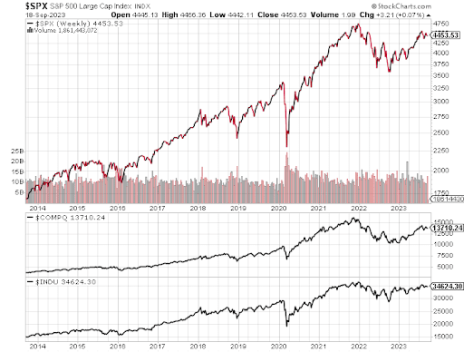There’s a saying that the market climbs a wall of worry, and nowhere is that more visible than in the performance of stocks this year.
While the U.S. economy has been surprisingly resilient, we’ve also had to contend with the March banking crisis, persistent fear of a recession, an aggressive Fed and ongoing inflationary battles.
Yet the market indices have powered higher through all of it. Add in the record amounts of cash on the sidelines, and there’s a strong case to be made that we’re still in the very early innings of a new bull market, which makes this a great time to invest.
Let me tell you why.
First, let me state clearly that the economy and the stock market are NOT the same thing. Yes, they are related but strength or weakness in one does not directly translate into strength or weakness in the other.
The most prominent example of this separation between the economy and the stock market in recent times was the first two years of the pandemic. Economies around the world were rocked by disruption to the supply chain, closures of schools and businesses, layoffs and furloughs, and more. And yet, the stock market performed remarkably during that time period. And then, as the economy got back on its feet in 2022, the market entered a bear market.
The current bull market began in mid-October last year and has shown steady progress with the S&P almost back to its high of early January 2022.
With that said, let’s look at how the economy is doing.
Unemployment and wages are where they should be. Over the past 50 years, unemployment has averaged 6.2% with spikes in November 1982 (10.8%), October 2009 (10.0%) and April 2020 (14.7%). Wage growth over that same time period has averaged 4.0% but has been generally 2-4% for most of that time. In the early 70s through the early 80s, wage growth exceeded the average as it did in the first year of the pandemic. Currently, unemployment is slightly below its historic average while wage growth is just slightly above.
Inflation has also been something we’ve heard a lot about in the last couple of years, so let’s look at that. The 50-year overall inflation average is 3.9%. We are currently at 3.7%. Core inflation (excluding food and energy) is currently running at 4.3%, higher than average, and food inflation is at 4.3%, again higher than average and perhaps the inflation consumers are most conscious of right now. At the same time, inflation in energy costs is currently running negative (-3.6% annual rate, compared to its historical average of 4.6%). The combined effect is that partisan politicians and pundits can point to successes or failures that suit their politics, but overall inflation is historically below average.
What about interest rates? The Federal Funds Rate has run near zero for much of the last 15 years but is currently up over 5% as the Fed has sought to gently cool off the economy to bring inflation back to preferred levels. It now appears the Fed MAY look for one or two more increases of 25 basis points (.25%) and that’s pretty well baked into market expectations. If inflation continues to moderate, it’s possible even that won’t be necessary. Many people in the financial community love to hate the Fed, but through a combination of their efforts and perhaps some lucky breaks, the proverbial “soft landing” seems increasingly likely, bringing inflation in check without unduly slowing the economy or increasing unemployment.
Overall, the economy is looking good. So let’s look at the stock market.
As I write this, the S&P is at 4,453, still below the January 2022 peak of 4,797 but not far off. You’ll see essentially the same thing with the Dow Jones and the NASDAQ. In fact, if you look at the 10-year charts for all three major indices you see very similar patterns.
- The markets climbed steadily from 2013 through 2019.
- Each had a sharp drop in March 2020 in the initial pandemic panic and all three quickly recovered.
- We then see a big bump up driven to a large extent by the massive amounts of money that were pumped into the economy to head off a pandemic meltdown.
- Starting early in 2022, all experienced a correction.
- And finally, in October of 2022, all resumed their climb.
Driven by pandemic-related uncertainty and rising returns, the amount of assets in money market funds has grown steadily and shot up sharply in late 2019 to its current record high of more than $5.6 trillion. That means there is a record amount of money sitting on the sidelines. As the market continues to experience sustained strength, and importantly as consumer confidence continues to grow, some of the assets in money market funds will come into the stock market. Increased demand and steady supply will result in higher prices and a rising market.
As always, the growth is not spread evenly. The top 10 stocks in the S&P 500 traditionally have a valuation premium (20.2 times earnings vs. 15.7 times earnings for the rest of the S&P) but that has grown significantly this year (28.9X for the top 10 vs. 18.3X).
And there is always rotation between sectors and cap size, going in and out of favor. But this is not something that should scare away investors. This rising and falling creates the conditions to make money for nimble investors.
This is not a market like 2021 when seemingly any dart thrown was a bull’s eye. Rather, this is a true stock picker’s market that requires expertise and a rigorous, time-tested investing system, just like those we employ here at Cabot.


